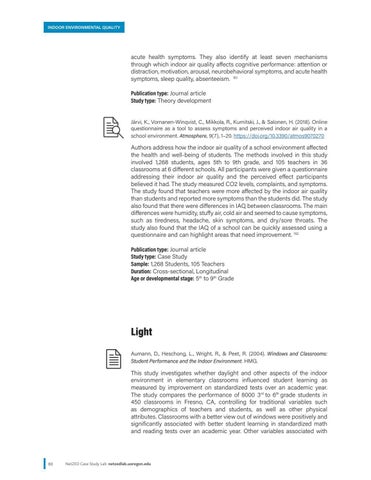INDOOR ENVIRONMENTAL QUALITY
acute health symptoms. They also identify at least seven mechanisms through which indoor air quality affects cognitive performance: attention or distraction, motivation, arousal, neurobehavioral symptoms, and acute health symptoms, sleep quality, absenteeism. 151 Publication type: Journal article Study type: Theory development Järvi, K., Vornanen-Winqvist, C., Mikkola, R., Kurnitski, J., & Salonen, H. (2018). Online questionnaire as a tool to assess symptoms and perceived indoor air quality in a school environment. Atmosphere, 9(7), 1–20. https://doi.org/10.3390/atmos9070270
Authors address how the indoor air quality of a school environment affected the health and well-being of students. The methods involved in this study involved 1,268 students, ages 5th to 9th grade, and 105 teachers in 36 classrooms at 6 different schools. All participants were given a questionnaire addressing their indoor air quality and the perceived effect participants believed it had. The study measured CO2 levels, complaints, and symptoms. The study found that teachers were more affected by the indoor air quality than students and reported more symptoms than the students did. The study also found that there were differences in IAQ between classrooms. The main differences were humidity, stuffy air, cold air and seemed to cause symptoms, such as tiredness, headache, skin symptoms, and dry/sore throats. The study also found that the IAQ of a school can be quickly assessed using a questionnaire and can highlight areas that need improvement. 152 Publication type: Journal article Study type: Case Study Sample: 1,268 Students, 105 Teachers Duration: Cross-sectional, Longitudinal Age or developmental stage: 5th to 9th Grade
Light Aumann, D., Heschong, L., Wright, R., & Peet, R. (2004). Windows and Classrooms: Student Performance and the Indoor Environment. HMG.
This study investigates whether daylight and other aspects of the indoor environment in elementary classrooms influenced student learning as measured by improvement on standardized tests over an academic year. The study compares the performance of 8000 3rd to 6th grade students in 450 classrooms in Fresno, CA, controlling for traditional variables such as demographics of teachers and students, as well as other physical attributes. Classrooms with a better view out of windows were positively and significantly associated with better student learning in standardized math and reading tests over an academic year. Other variables associated with
80
NetZED Case Study Lab netzedlab.uoregon.edu

